Closed-Form Expressions for the Analysis of Wave Propagation in Overhead Distribution Lines
Abstract
:1. Introduction
- The relative permeability of the soil is taken equal to unity.
- The influence of the displacement current in the air and earth on the earth’s impedance is neglected.
- Quasi-static transverse electromagnetic (quasi-TEM) field propagation is assumed [4].
2. Earth Impedance and Admittance Formulas
2.1. Earth Impedance Closed-Form Expressions
2.1.1. Sunde’s Expression
2.1.2. Dubanton’s Expression
2.1.3. Alvarado–Betancourt Expression
2.1.4. Noda’s Expression
2.2. Generalized Earth Formulation: Impedance and Admittance Formulas
2.2.1. Frequency Regions
- Low frequency region for : the displacement current is negligible and the earth behaves as a conductor.
- Transition region for : displacement and resistive currents are comparable. The earth behaves both as a conductor and an insulator.
- Very high frequency or surface wave region for : the displacement current is predominant and the earth behaves mainly as an insulator.
2.2.2. Pettersson’s Closed-Form Expressions
3. Sensitivity Analysis
4. Per-Unit-Length Parameter Results
4.1. Accuracy Assessment of Impedance Formulas
4.1.1. Evaluation of the Closed-Form Earth Impedance Expressions
4.1.2. Effect of the Horizontal Distance on the Mutual Impedance
4.1.3. Effect of the Vertical Distance on the Mutual Impedance
4.2. Influence of Displacement Currents
4.3. Influence of the Imperfect Earth on OHL Admittance
5. Modal Analysis
5.1. Propagation Characteristics
5.2. Modal Transformation
6. Responses
6.1. Frequency-Domain Signal Scans
6.1.1. Evaluation of the Effect of Closed-Form Earth Impedance Expressions
6.1.2. Evaluation of Different Earth Approaches
6.2. Transient Responses
7. Conclusions
Author Contributions
Funding
Conflicts of Interest
References
- Carson, J.R. Wave propagation in overhead wires with ground return. Bell Syst. Tech. J. 1926, 5, 539–554. [Google Scholar] [CrossRef]
- Wait, J.R. Theory of wave propagation along a thin wire parallel to an interface. Radio Sci. 1972, 7, 675–679. [Google Scholar] [CrossRef]
- Papadopoulos, T.A.; Papagiannis, G.K. Influence of earth permittivity on overhead transmission line earth-return impedances. IEEE Lausanne Power Tech. 2007, 790–795. [Google Scholar] [CrossRef]
- Tomasevich, M.Y.; Lima, A.C.S. Investigation on the limitation of closed-form expressions for wideband modeling of overhead transmission lines. Electr. Power Syst. Res. 2016, 130, 113–123. [Google Scholar] [CrossRef]
- Hofman, L. Series expansions for line series impedances considering different specific resistances, magnetic permeabilities, and dielectric permittivities of conductors, air, and ground. IEEE Trans. Power Deliv. 2003, 18, 564–570. [Google Scholar] [CrossRef]
- Papagiannis, G.K.; Tsiamitros, D.A.; Labridis, D.P.; Dokopoulos, P.S. A systematic approach to the evaluation of the influence of multilayered Earth on overhead power transmission lines. IEEE Trans. Power Deliv. 2005, 20, 2594–2601. [Google Scholar] [CrossRef]
- Triantafyllidis, D.G.; Papagiannis, G.K.; Labridis, D.P. Calculation of overhead transmission line impedances a finite element approach. IEEE Trans. Power Deliv. 1999, 14, 287–293. [Google Scholar] [CrossRef]
- Papagiannis, G.K.; Triantafyllidis, D.G.; Labridis, D.P. A one-step finite element formulation for the modeling of single and double-circuit transmission lines. IEEE Trans. Power Deliv. 2000, 15, 33–38. [Google Scholar] [CrossRef]
- Dubanton, C. Calcul approche des parametres et secondaires d’une ligne detransport. EDF Bulletin de la Direction des Études et Recherches 1969, 1, 53–62. [Google Scholar]
- Gary, C. Approche complète de la propagation multifilaire en haute fréquence par utilisation des matrices complexes. E.D.F. Bulletin de la Direction des Études et Recherches, Série B-Réseaux Électriques Matériels 1976, 3–4, 5–20. [Google Scholar]
- Deri, A.; Tevan, G.; Semlyen, A.; Castanheira, A. The complex ground return plane: A simplified model for homogeneous and multi-layer earth return. IEEE Trans. Power Appar. Syst. 1981, 100, 3686–3693. [Google Scholar] [CrossRef]
- Sunde, E.D. Earth Conduction Effects in Transmission Systems, 2nd ed.; Dover Publications: New York, NY, USA, 1968; pp. 99–139. [Google Scholar]
- Rachidi, F.; Nucci, C.A.; Ianoz, M. Transient analysis of multiconductor lines above a lossy ground. IEEE Trans. Power Deliv. 1999, 14, 294–302. [Google Scholar] [CrossRef]
- Semlyen, A. Ground return parameters of transmission lines—An asymptotic analysis for very high frequencies. IEEE Trans. Power Appar. Syst. 1981, 100, 1031–1038. [Google Scholar] [CrossRef]
- Alvarado, F.L.; Betancourt, R. An accurate closed-form approximation for ground return impedance calculations. Proc. IEEE 1983, 71, 279–280. [Google Scholar] [CrossRef]
- Noda, T. A double logarithmic approximation of Carson’s ground-return impedance. IEEE Trans. Power Deliv. 2006, 21, 472–479. [Google Scholar] [CrossRef]
- Theodoulidis, T. On the closed-form expression of Carson’s integral. Period. Polytech. Electr. Eng. Comput. Sci. 2015, 59, 26–29. [Google Scholar] [CrossRef] [Green Version]
- Theethayi, N.; Thottappillil, R.; Liu, Y.; Montano, R. Important parameters that influence crosstalk in multiconductor transmission lines. Electr. Power Syst. Res. 2007, 77, 896–909. [Google Scholar] [CrossRef]
- Wise, W.H. Propagation of high frequency currents in ground return circuits. Proc. Inst. Radio Eng. 1934, 22, 522–527. [Google Scholar] [CrossRef]
- Wise, W.H. Effect of ground permeability on ground return circuits. Bell Syst. Tech. J. 1931, 10, 472–484. [Google Scholar] [CrossRef]
- Wise, W.H. Potential coefficients for ground return circuits. Bell Syst. Tech. J. 1948, 27, 365–371. [Google Scholar] [CrossRef]
- Kikuchi, H. Wave propagation along an infinite wire above ground at high frequencies. Electrotech. J. Jpn. 1956, 2, 73–78. [Google Scholar]
- Ametani, A.; Miyamoto, Y.; Baba, Y.; Nagaoka, N. Wave propagation on an overhead multiconductor in a high-frequency region. IEEE Trans. Electromagn. Compat. 2014, 56, 1638–1648. [Google Scholar] [CrossRef]
- Pettersson, P. Image representation of wave propagation on wires above, on and under ground. IEEE Trans. Power Deliv. 1994, 9, 1049–1055. [Google Scholar] [CrossRef]
- D’Amore, M.; Sarto, M.S. Simulation models of a dissipative transmission line above a lossy ground for a wide-frequency range. I. Single conductor configuration. IEEE Trans. EMC 1996, 38, 127–138. [Google Scholar] [CrossRef]
- D’Amore, M.; Sarto, M.S. Simulation models of a dissipative transmission line above a lossy ground for a wide-frequency range. II. Multiconductor configuration. IEEE Trans. EMC 1996, 38, 139–149. [Google Scholar] [CrossRef]
- Nakagawa, N.; Ametani, A.; Iwamoto, K. Further studies on wave propagation in overhead lines with earth return: Impedance of stratified earth. Proc. Inst. Electr. Eng. 1973, 120, 1521–1528. [Google Scholar] [CrossRef]
- Tsiamitros, D.A.; Papagiannis, G.K.; Dokopoulos, P.S. Earth Return Impedances of Conductor Arrangements in Multilayer Soils—Part I: Theoretical Model. IEEE Trans. Power Deliv. 2008, 23, 2392–2400. [Google Scholar] [CrossRef]
- Papadopoulos, T.A.; Papagiannis, G.K.; Labridis, D.P. A generalized model for the calculation of the impedances and admittances of overhead power lines above stratified earth. Electr. Power Syst. Res. 2010, 80, 1160–1170. [Google Scholar] [CrossRef]
- Ramos-Leaños, O.; Naredo, J.L.; Uribe, F.A.; Guardado, J.L. Accurate and Approximate Evaluation of Power-Line Earth Impedances through the Carson Integral. IEEE Trans. Electromagn. Compat. 2017, 59, 1465–1473. [Google Scholar] [CrossRef]
- Longmire, C.L.; Smith, K.S. A Universal Impedance for Soils; DNA 3788T.; Mission Research Corp.: Santa Barbara, CA, USA, 1975. [Google Scholar]
- CIGRE WG C4.33. Impact of Soil-Parameter Frequency Dependence on the Response of Grounding Electrodes and on the Lightning Performance of Electrical Systems; Technical Brochure 781; CIGRE: Paris, France, 2019. [Google Scholar]
- Lima, A.C.S.; Portela, C. Inclusion of frequency-dependent soil parameters in transmission-line modeling. IEEE Trans. Power Deliv. 2007, 22, 492–499. [Google Scholar] [CrossRef]
- Tomasevich, M.M.Y.; Lima, A.C.S. Impact of frequency-dependent soil parameters in the numerical stability of image approximation-based line models. IEEE Trans. Electromagn. Compat. 2016, 58, 323–326. [Google Scholar] [CrossRef]
- Schroeder, M.A.O.; de Barros, M.T.C.; Lima, A.C.S.; Afonso, M.M.; Moura, R.A.R. Evaluation of the impact of different frequency dependent soil models on lightning overvoltages. Electr. Power Syst. Res. 2018, 159, 40–49. [Google Scholar] [CrossRef]
- Lima, G.S.; De Conti, A. Bottom-up single-wire power line communication channel modeling considering dispersive soil characteristics. Electr. Power Syst. Res. 2018, 165, 35–44. [Google Scholar] [CrossRef]
- Chrysochos, A.I.; Papadopoulos, T.A.; ElSamadouny, A.; Papagiannis, G.K.; Al-Dhahir, N. Optimized MIMO-OFDM design for narrowband-PLC applications in medium-voltage smart distribution grids. Electr. Power Syst. Res. 2016, 140, 253–262. [Google Scholar] [CrossRef]
- PSCAD Simulation Software. Available online: https://www.pscad.com/ (accessed on 6 June 2020).
- Semlyen, A. Accuracy limits in the computed transients on overhead lines due to inaccurate ground return modeling. IEEE Trans. Power Deliv. 2002, 17, 872–878. [Google Scholar] [CrossRef]
- Ametani, A.; Lafaia, I.; Miyamoto, Y.; Asada, T.; Baba, Y.; Nagaoka, N. High-frequency wave-propagation along overhead conductors by transmission line approach and numerical electromagnetic analysis. Electr. Power Syst. Res. 2016, 136, 12–20. [Google Scholar] [CrossRef]
- Fernandes, A.B.; Neves, W.L.A. Phase-domain transmission line models considering frequency-dependent transformation matrices. IEEE Trans. Power Deliv. 2004, 19, 708–717. [Google Scholar] [CrossRef]
- Nakagawa, M. Admittance correction effects of a single overhead line. IEEE Trans. Power Syst. 1981, 100, 1154–1161. [Google Scholar] [CrossRef]
- Wedepohl, L.M.; Nguyen, H.V.; Irwin, G.D. Frequency-dependent transformation matrices for untransposed transmission lines using Newton-Raphson method. IEEE Trans. Power Deliv. 1996, 11, 1538–1546. [Google Scholar] [CrossRef]
- Nguyen, T.T.; Chan, H.Y. Evaluation of modal transformation matrices for overhead transmission lines and underground cables by optimization method. IEEE Trans. Power Deliv. 2002, 17, 200–209. [Google Scholar] [CrossRef]
- Chrysochos, A.I.; Papadopoulos, T.A.; Papagiannis, G.K. Robust calculation of frequency-dependent transmission line transformation matrices using the Levenberg-Marquardt method. IEEE Trans. Power Deliv. 2014, 29, 1621–1629. [Google Scholar] [CrossRef]
- Chrysochos, A.I.; Papadopoulos, T.A.; Papagiannis, G.K. Enhancing the frequency-domain calculation of transients in multiconductor power transmission lines. Electr. Power Syst. Res. 2015, 122, 56–64. [Google Scholar] [CrossRef]
- OHLToolbox. Available online: https://utopia.duth.gr/~thpapad/ (accessed on 10 June 2020).
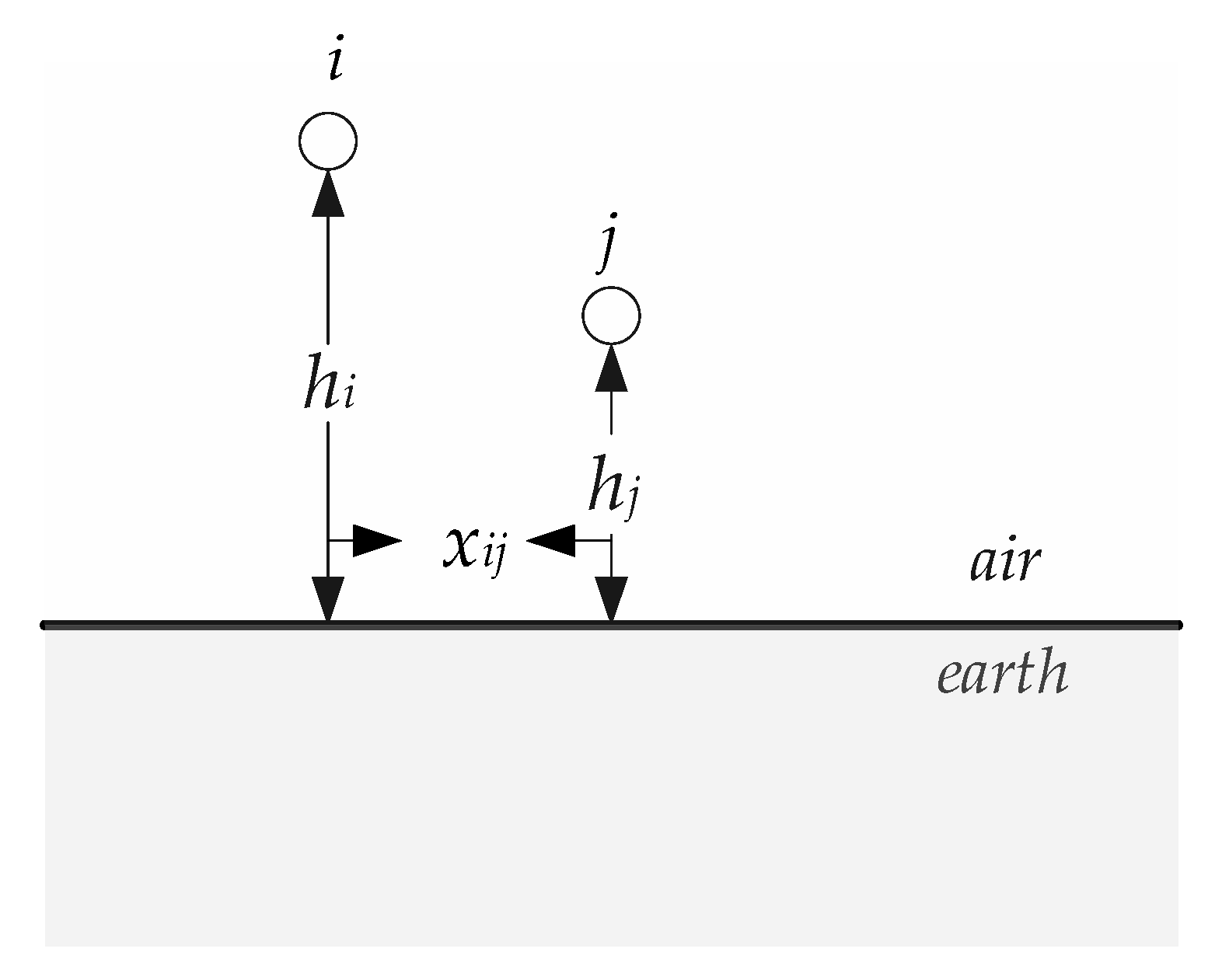


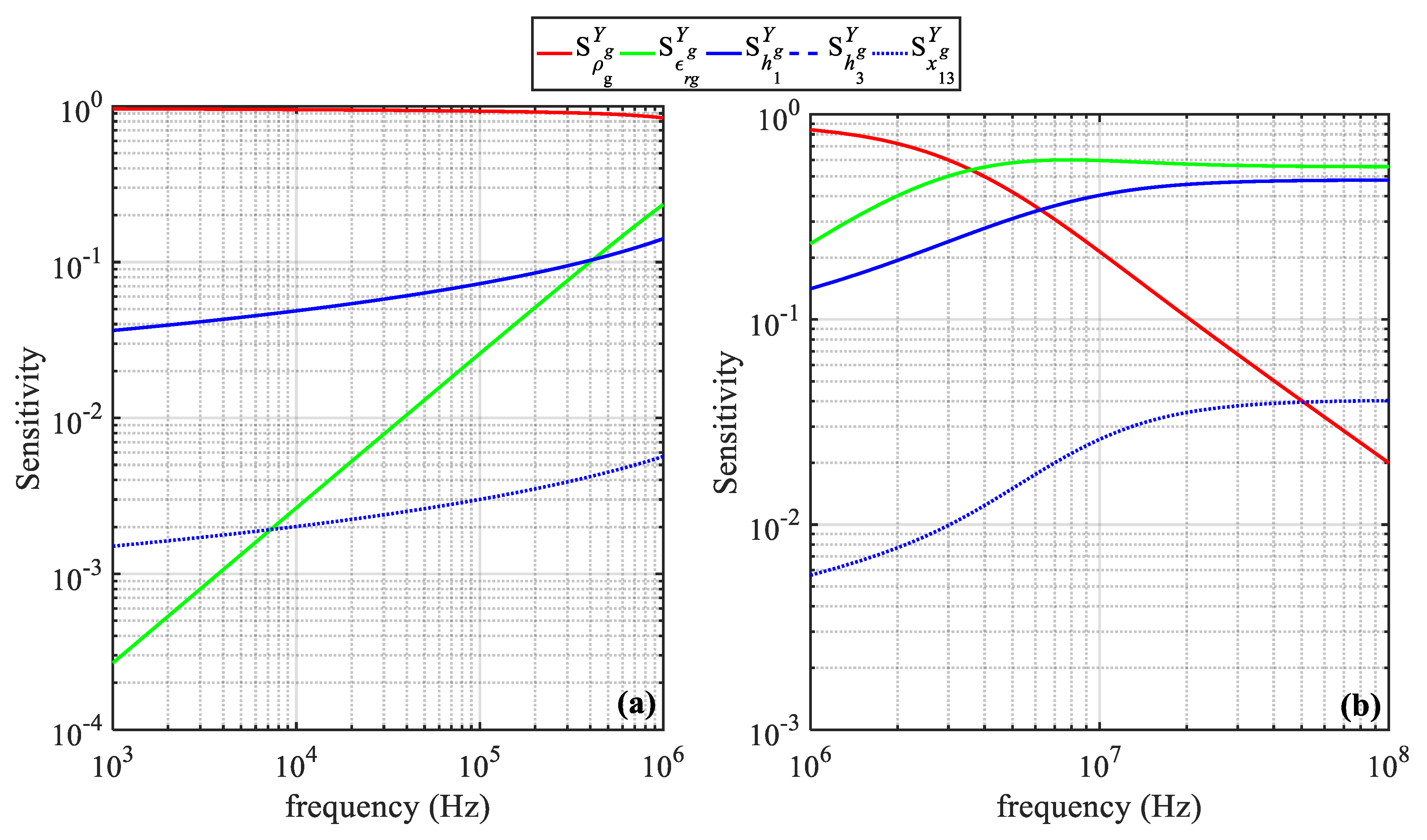


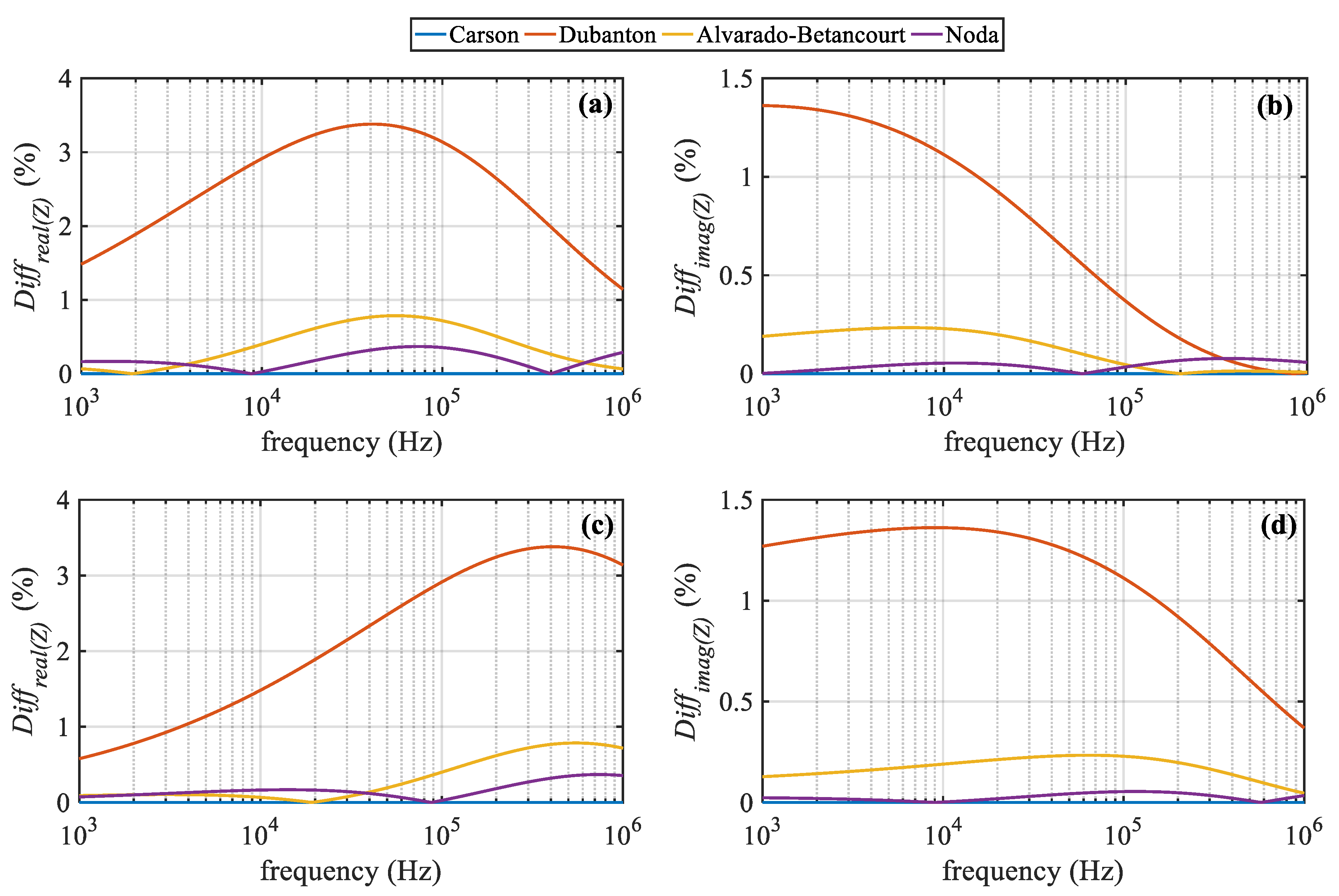


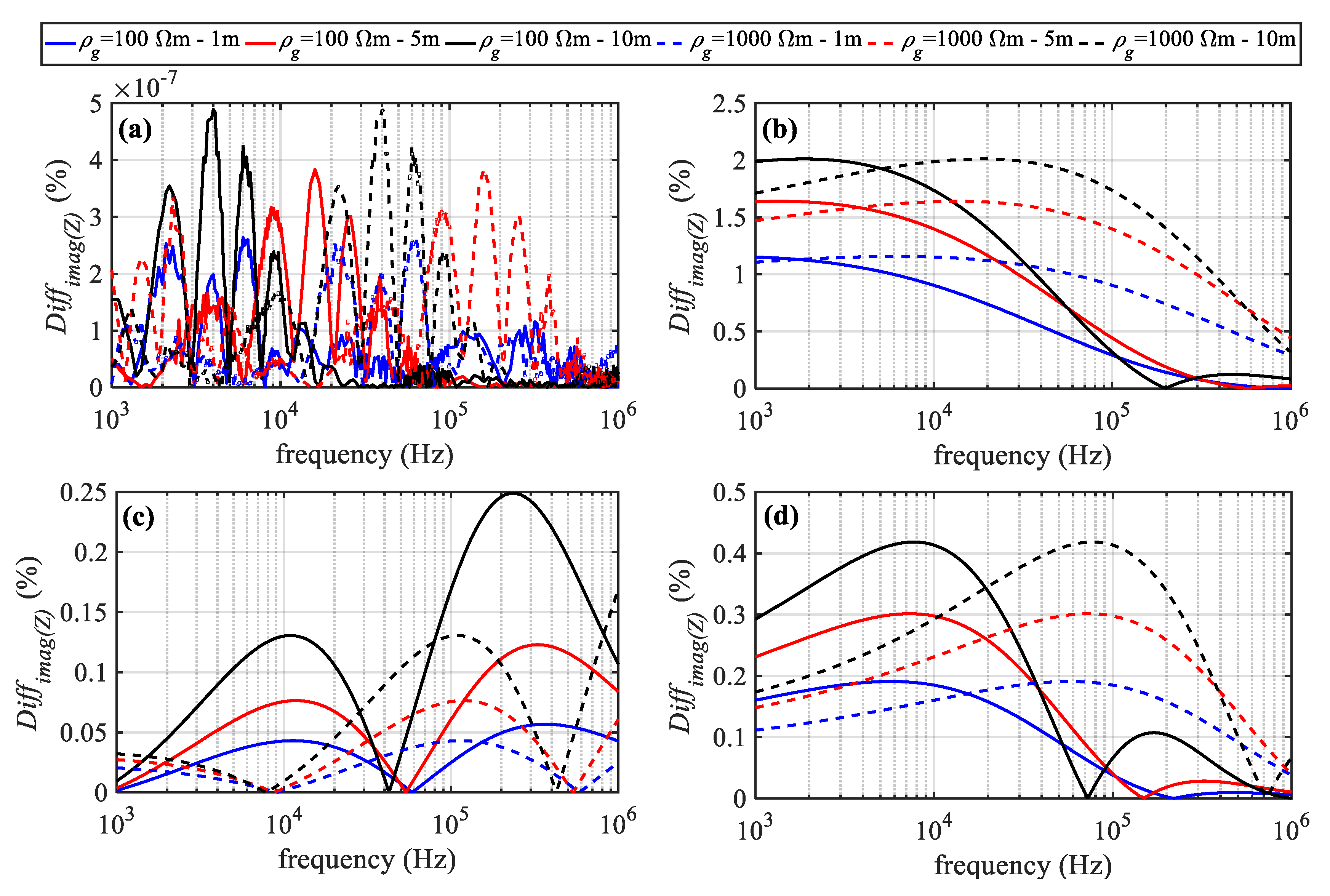

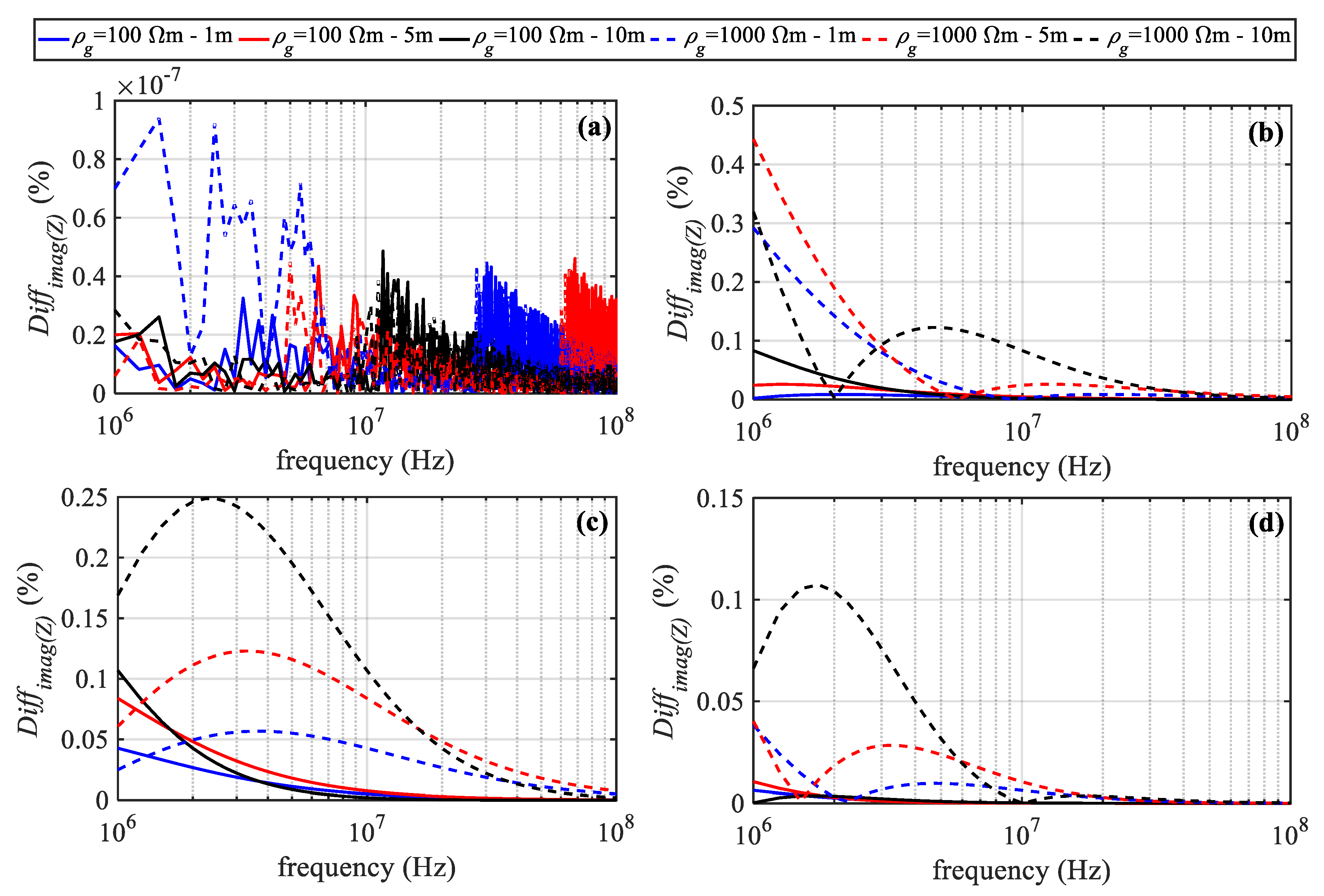


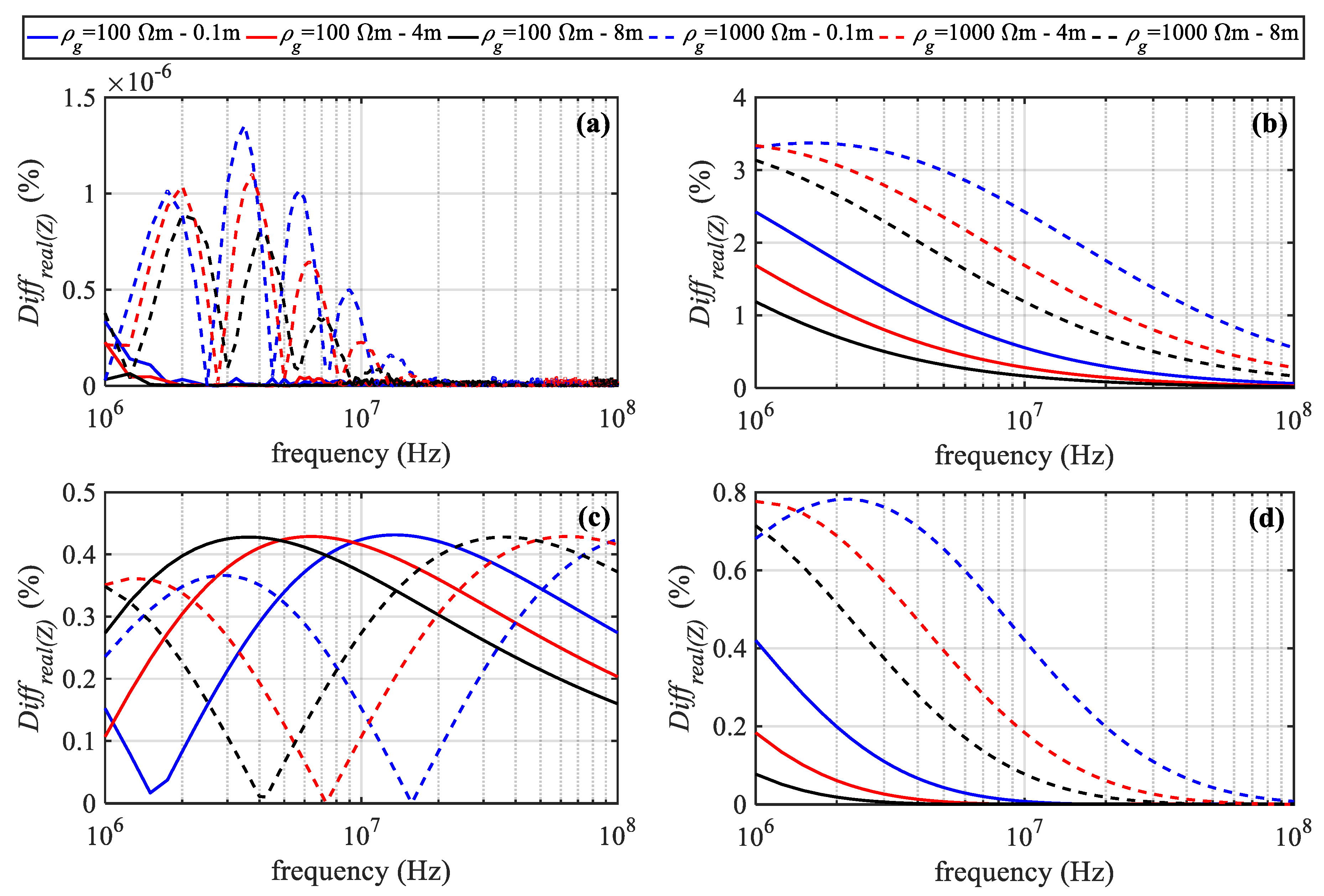
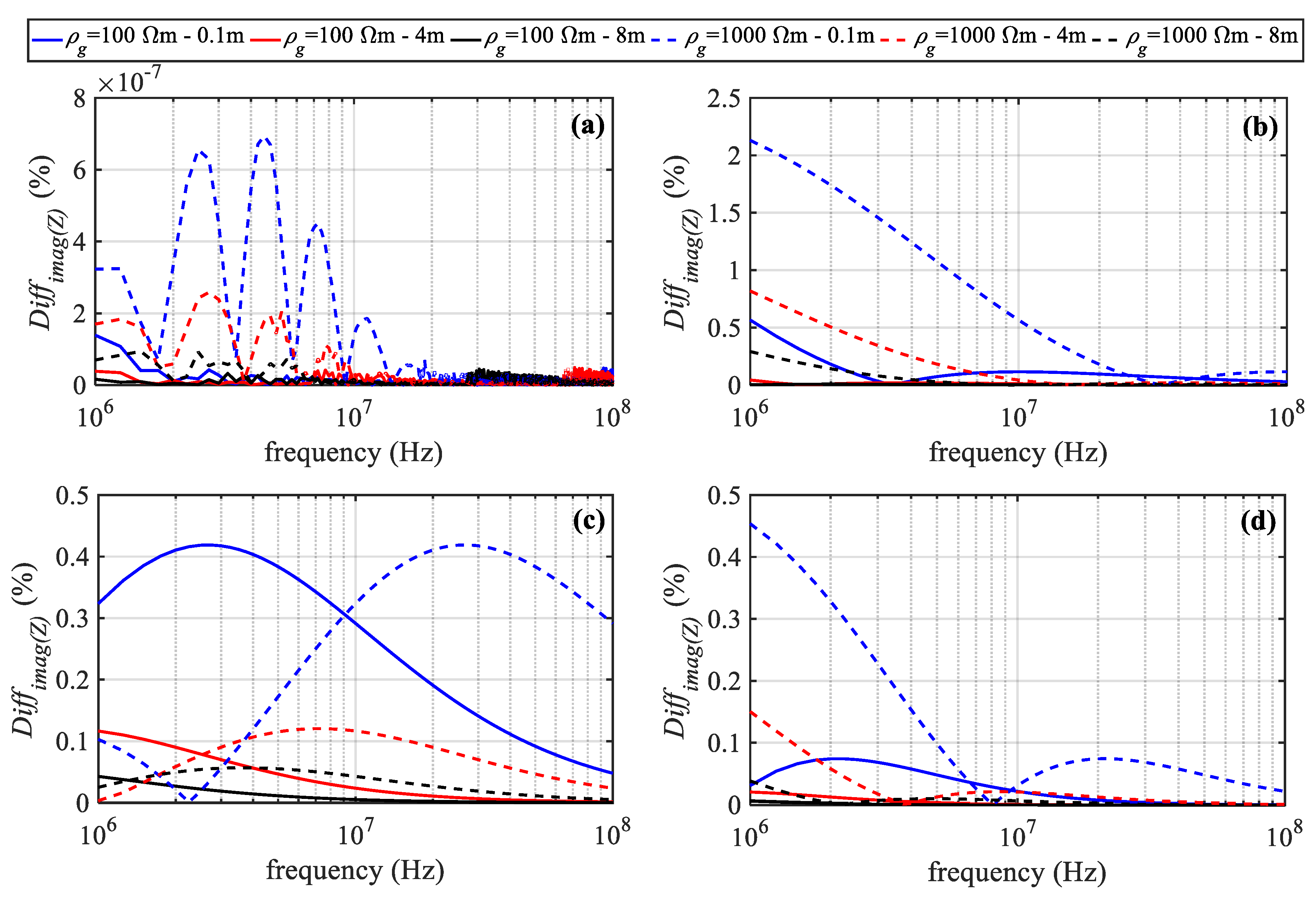

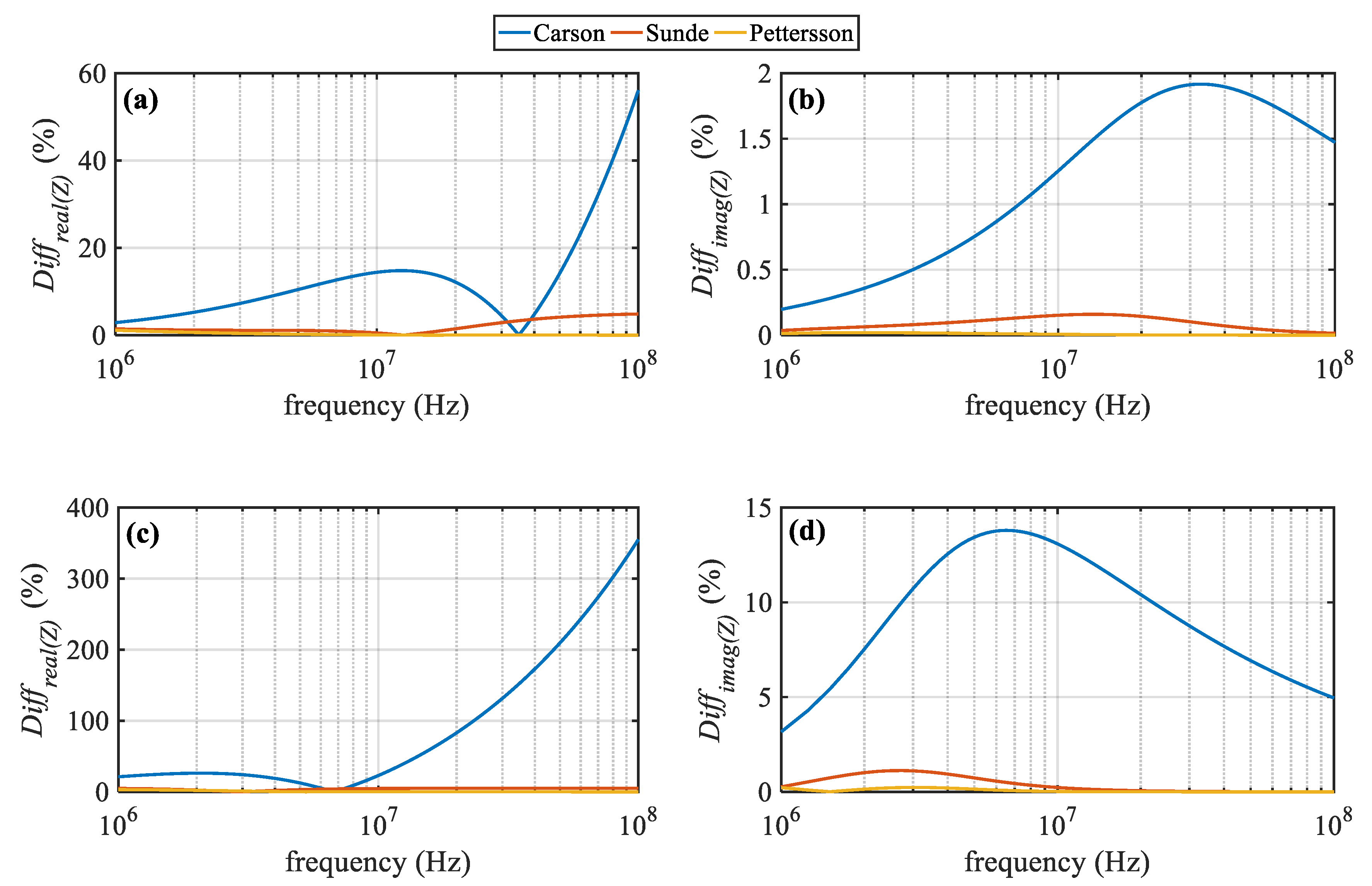

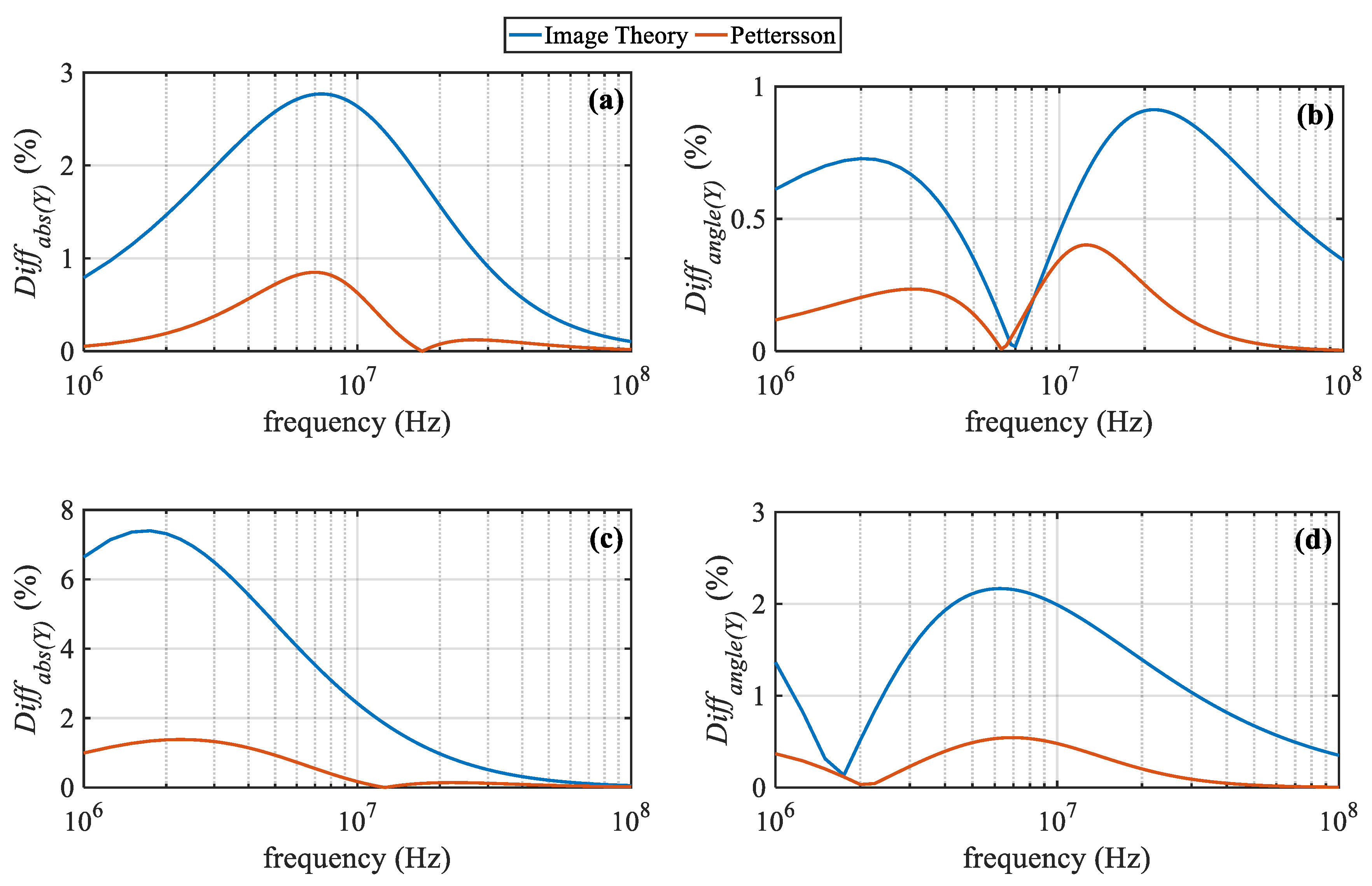


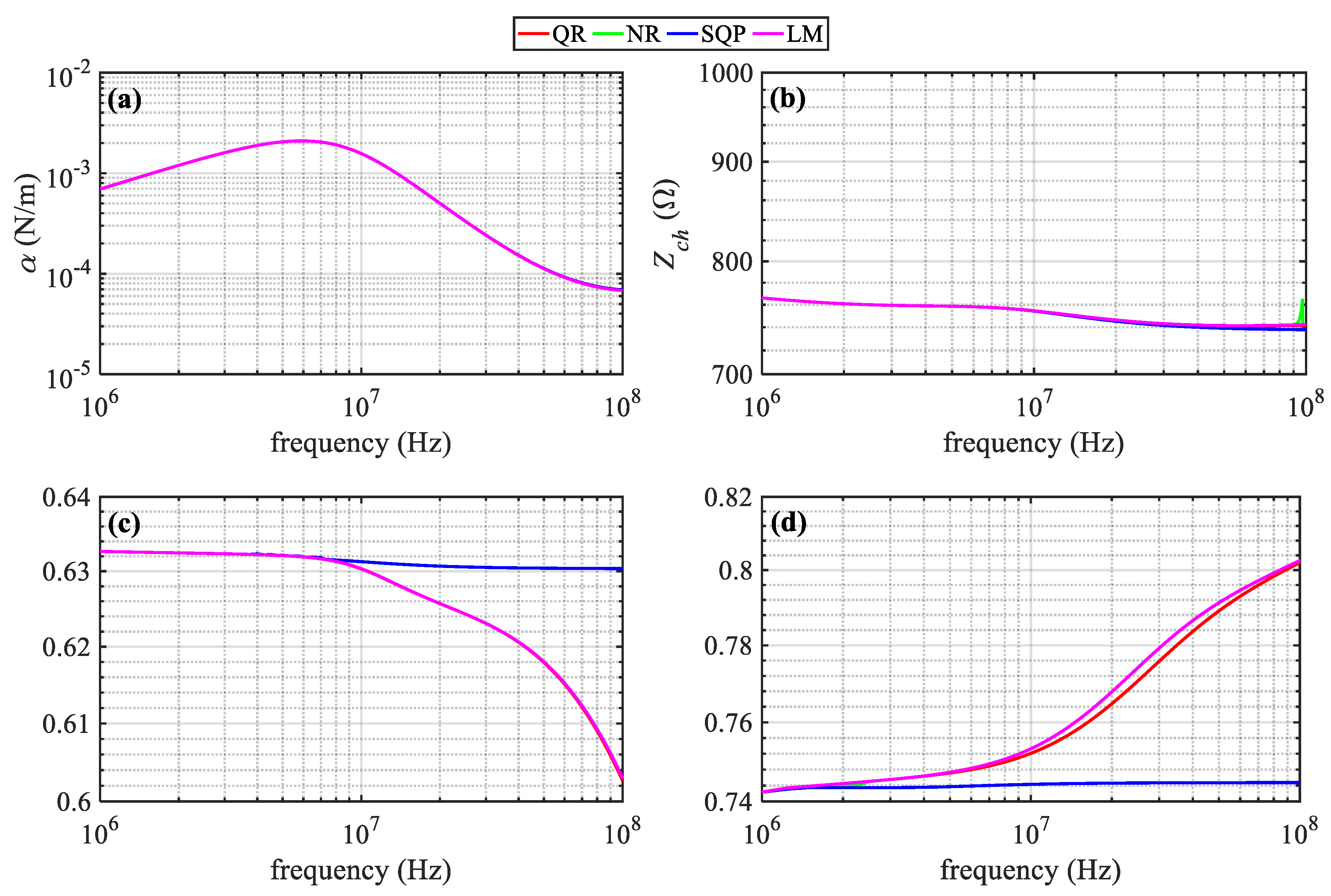



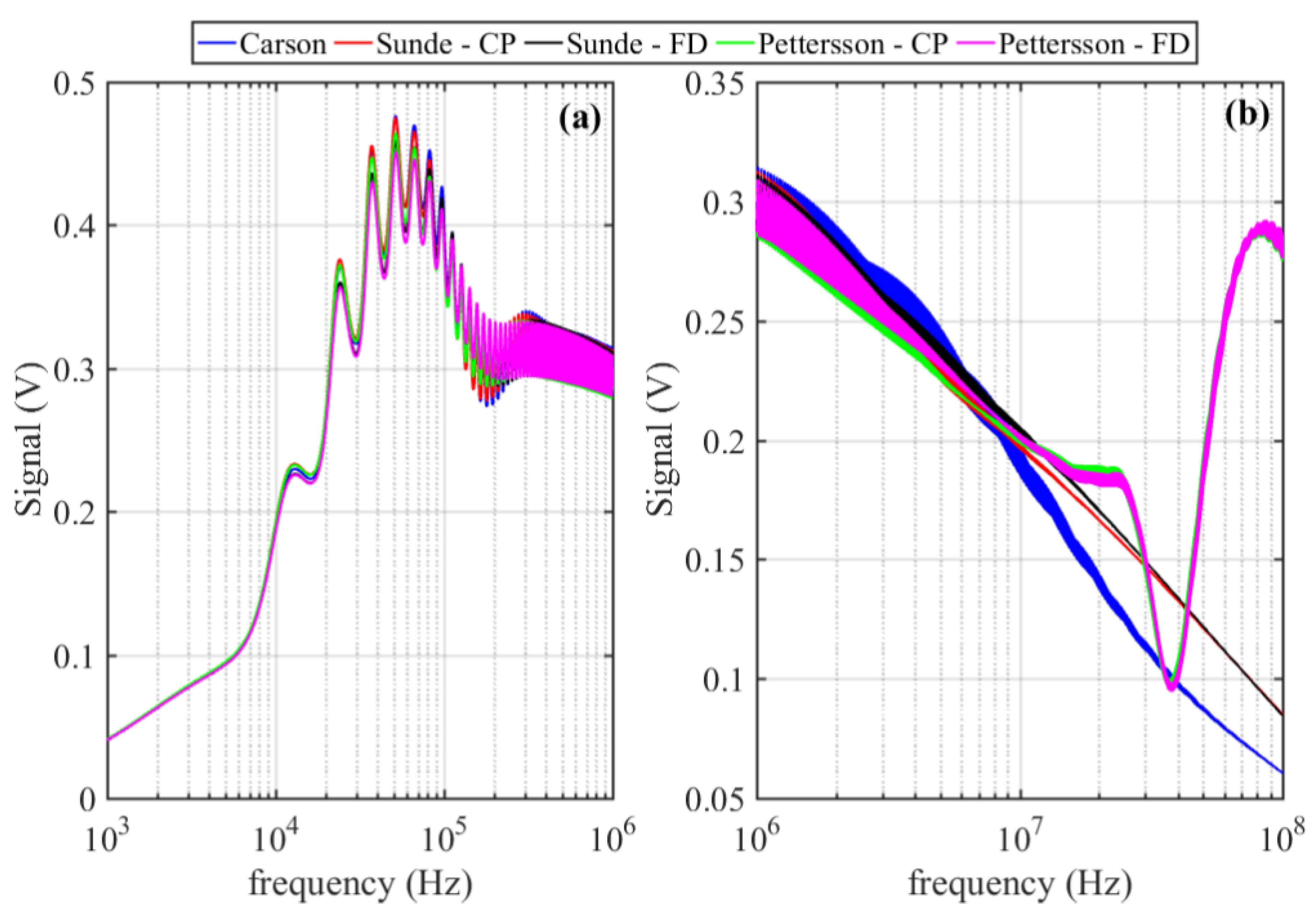

© 2020 by the authors. Licensee MDPI, Basel, Switzerland. This article is an open access article distributed under the terms and conditions of the Creative Commons Attribution (CC BY) license (http://creativecommons.org/licenses/by/4.0/).
Share and Cite
Papadopoulos, T.A.; Chrysochos, A.I.; Traianos, C.K.; Papagiannis, G. Closed-Form Expressions for the Analysis of Wave Propagation in Overhead Distribution Lines. Energies 2020, 13, 4519. https://doi.org/10.3390/en13174519
Papadopoulos TA, Chrysochos AI, Traianos CK, Papagiannis G. Closed-Form Expressions for the Analysis of Wave Propagation in Overhead Distribution Lines. Energies. 2020; 13(17):4519. https://doi.org/10.3390/en13174519
Chicago/Turabian StylePapadopoulos, Theofilos A., Andreas I. Chrysochos, Christos K. Traianos, and Grigoris Papagiannis. 2020. "Closed-Form Expressions for the Analysis of Wave Propagation in Overhead Distribution Lines" Energies 13, no. 17: 4519. https://doi.org/10.3390/en13174519




